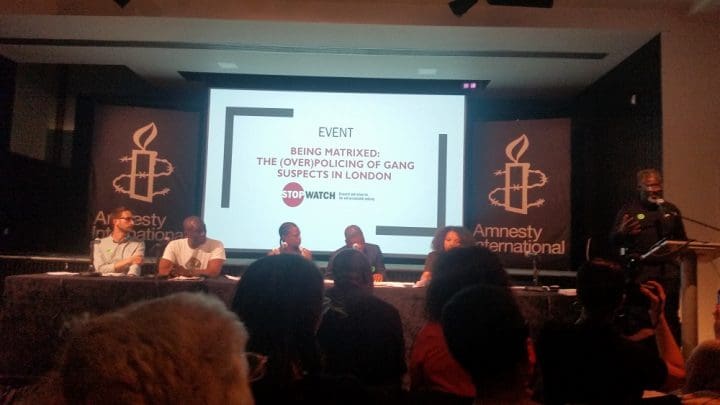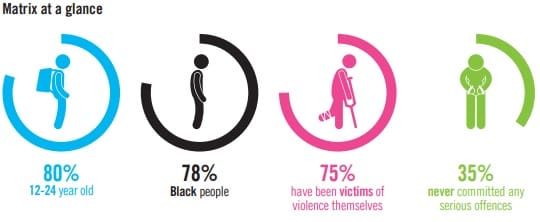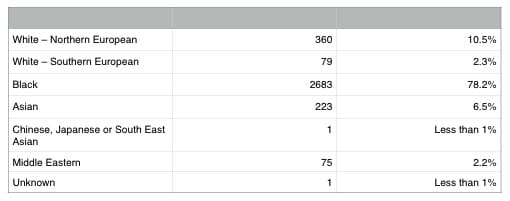A new report by police accountability coalition StopWatch blasts the Metropolitan Police Service’s (MPS) racialised gangs database as “draconian” and counterproductive. In a statement, chief executive of StopWatch Katrina Ffrench said:
Not only is the Matrix completely ineffective at combating the crime it claims to want to tackle, our research suggests it makes crime more likely.
The MPS database is called the Gangs Matrix and was formed in 2012 following the London riots.
The report, Being Matrixed: The (Over)Policing of Gang Suspects in London, tracks the lived experiences of 15 people aged 17-32 on the database.
The Canary attended the launch on 19 September.

Ignore austerity, blame minorities
Stafford Scott, an anti-racist and civil liberties campaigner, put the report into context:
This war between the police and young Black people has being going on since the Windrush. This particular iteration of this war began after the execution of Mark Duggan… in a time of austerity, in a time of economic downturn the system always look at people to blame.
They didn’t want to talk about austerity, so they talked about “the gangs”. They had four reviews – one was the police’s own review … there was no evidence that gangs orchestrated violence, but it didn’t stop the government.
The report’s recommendations include abolishing the Gangs Matrix and ensuring that “no similar gang database systems are created”, and that proper regulation of the Matrix should be implemented until it is abolished.
Guilt by association
The police use the Matrix to “rank London’s suspected gang members according to their ‘propensity for violence’ “. But, according to the MPS’s own ranking system, 64% of those on the Matrix were marked as posing the least risk. An Amnesty International report also showed that 35% have never committed a ‘serious offence’, and 40% “have no record of involvement in any violent offence in the last two years”.
Disturbingly, a criminal conviction isn’t necessary to end up on the database. Simply knowing someone on the database is enough. And it’s difficult to know:
- If you’re on it.
- How you got onto it.
- What it takes to get off it.
Orwellian
A pre-crime space exists for those on the Matrix. People are targeted not out of ‘reasonable suspicion’ that they’re engaging in criminal activity, but of suspicion they may engage in criminal activity because of inclusion on the Gangs Matrix.
Ffrench stated:
To be on the Matrix is to be literally black listed. It means that the young people on it are marked out for harassment and humiliation. It’s a highly racialised stigma that follows someone through every aspect of their life.
This often takes the form of stop and search. But most searches never lead to a conviction. In 2016/17, only 17% of Section 1 stops led to an arrest.
‘Intelligence-led’
The Matrix is a product of a push towards more ‘intelligence-led’ policing. This includes “mining of social media accounts” and using algorithms to analyse the data. But the ‘intelligence’ of this process is open for debate.
One interviewee explained how unaccountable the whole process is:
The thing what pisses me off is that they [police] have the power to do stuff, extra stuff, and their power derives from intelligence. You can ask them, ‘What’s the intelligence?’ They’ll say they’re not allowed to tell you. [I]t’s not proven in court. So why is it [intelligence] allowing you the powers to come to oppress me…[y]ou’re oppressing me with power that you shouldn’t even have.
Humiliated
The report says “contrary to popular misconception” those targeted:
describe initially having a positive attitude and helpful experience of the police.
But this changes as the interviewees became older and were subjected to stop and searches:
In the words of a 21-year-old on the Gangs Matrix:
They think they know me. They don’t know me…
They think they know you because they see things on paper and they think they can make a judgement… “No, you can’t search me. I am not going to bow down to you because you found out I have been in trouble with the police. I haven’t got any drugs.
The report says:
these initial stop and search encounters serve as scars of the police humiliation they experienced as children and consequently severely impacted their trust and confidence in the police.
Routine humiliation by the state is self-evident upon reading the report as Ffrench explained:
The young people we work with describe being stopped and searched as a daily occurrence, like putting on clothes – some people report being stopped and searched as many as three times a day. I think it’s hard for most people to imagine that level of invasion of personal space and the mental strain the young people experience.
Racialised
Figures from 2016 show that 78% of people on the MPS Gang Matrix are ‘Black; another 9% come from Asian and other minority groups. A grossly disproportionate number “given the Met’s own figures show that only 27% of those responsible for serious youth violence are black”.
The Canary understands that in Manchester the Gangs Matrix has a similar ethnic make-up.

SOURCE: Metropolitan Police Service
CREDIT: Amnesty International UK
Law professor Lee Bridges observed in 2015:
It is interesting to note how ethnicity is defined [by the MPS]. While four of the six categories are geographically based, with ‘whites’ being divided between Northern and Southern European origins, no such differentiation is made for either ‘black’ or ‘Asian’ people on the database, both being taken as blanket categories based purely on race or ethnicity.

But what is even more remarkable is that the Met could claim that there are only 439 white people in the whole of London who are engaged on an organised basis in ‘violence, criminal offending and gang membership’, which is the purported basis for inclusion on the database. Once account is taken of such organised criminal activities as drug-dealing; sex and people trafficking; multi-handed robbery: fraud: theft (including auto theft ) and extortion; football hooliganism; and racist violence, these figures are simply not credible.
Excluded from society
While the report focuses largely on stop and searches, it also details people excluded from education, learning resources, and housing.
One person interviewed wasn’t able to get “the accommodation that he had already signed the tenancy agreement on” despite being homeless. A ‘banning order’ meant he was banished from his community and couldn’t contact his friends.
It’s no wonder that report author Dr Patrick Williams said the following during the launch:
The hostile environment is not a new idea. Essentially, to be matrixed means to be placed in a deliberate hostile environment.
Managing disorder rather than fighting crime
Sociologist Alex Vitale explains in his book The End of Policing that the creation of the MPS:
had at its core not fighting crime, but managing disorder and protecting the propertied classes from the rabble. [The founder of the MPS Sir Robert] Peel developed his ideas while managing the British colonial occupation of Ireland and seeking new forms of social control that would allow for continued political and economic domination in the face of growing insurrections, riots, and political uprisings.
If harassing people and containing Black and working-class populations remains the job of the police, then it is an objective that they successfully achieve. But for anyone concerned about tackling the root causes of crime, the findings and recommendations of this report must be considered seriously in order to shift state policy towards a more just situation.
The Canary contacted the Met Police for comment but had not received a response at the time of publication.
Get Involved!
– Learn more about the work of StopWatch and read their reports.
– Write to your MP and tell them to push for the abolition of these types of gangs matrices.
– Support independent journalism at The Canary.
Featured image via Emily Apple
Images in article via Mohamed Elmaazi, Amnesty International UK, Professor Lee Bridges















